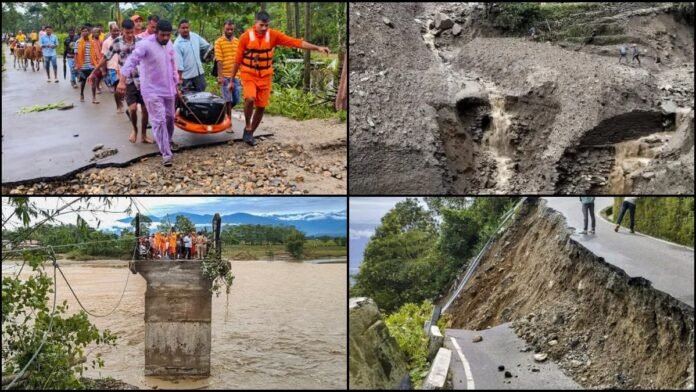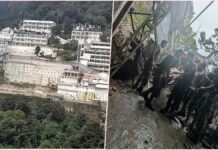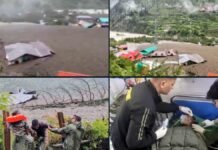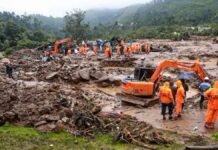
Key Points
- At least 23 people, including seven children, have been killed in devastating landslides across Darjeeling, Mirik, and Jalpaiguri districts triggered by relentless rainfall on Sunday, October 5, 2025
- Over 300 mm of rainfall was recorded in just 12 hours, causing landslides at 35 locations across the region, marking the worst such disaster since 2015 when 40 lives were lost
- Mirik suffered the highest casualties with 11 confirmed deaths, followed by seven fatalities in other parts of Darjeeling district and five deaths in Nagrakata area of Jalpaiguri
- The catastrophe has completely severed road connectivity on key routes including National Highway 55, Mirik-Sukhiapokhri road, and NH10, with an iron bridge connecting Siliguri to Darjeeling severely damaged
- Hundreds of tourists who arrived for Durga Puja holidays remain stranded in Mirik, Ghoom, and Lepchajagat as rescue operations continue amid hazardous conditions
- Chief Minister Mamata Banerjee held emergency meetings and announced she would visit North Bengal on Monday, October 6, while Prime Minister Narendra Modi assured all possible central assistance
- India Meteorological Department has issued a red alert for Darjeeling, Kalimpong, Jalpaiguri, and Cooch Behar, warning of more landslides and flash floods as rain continues
Darjeeling: West Bengal’s picturesque hill districts of Darjeeling, Mirik, and Jalpaiguri witnessed one of the worst natural disasters in a decade on Sunday, October 5, 2025, as relentless rainfall triggered massive landslides that claimed at least 23 lives and left scores injured. The tragedy unfolded as over 300 mm of rain pounded the region in just 12 hours, causing hillsides to collapse and burying homes, roads, and entire settlements under tons of mud and debris.
According to reports compiled by the National Disaster Response Force (NDRF) and district administration, fatalities have been confirmed from multiple locations including Sarsaly, Jasbirgaon, Mirik Basti, Dhar Gaon (Mechi), Nagrakata, and the Mirik Lake area. Officials have warned that the death toll is likely to rise as rescue operations continue in inaccessible areas where communication lines have been severed and terrain remains treacherous.
Mirik Bears the Brunt of Nature’s Fury
The worst-affected area remains Mirik, a popular tourist destination in Darjeeling district, where 11 people have been confirmed dead and seven injured have been rescued from landslide-affected zones. Entire homes were flattened by cascading mud and debris as hillsides gave way under the pressure of unprecedented rainfall.
In other parts of Darjeeling district, seven more people lost their lives due to major landslides triggered by the heavy rainfall that began Saturday night. Darjeeling Sub-Divisional Officer (SDO) Richard Lepcha confirmed that rescue and relief operations were underway with support from police, local administration, and disaster response teams.
The Jalpaiguri district, particularly the Nagrakata area, reported five additional fatalities, bringing the regional death toll to 23 as of Monday morning. The NDRF successfully rescued 40 people from Dhar Gaon in Nagarakata, where mudslides destroyed multiple homes.
Worst Disaster Since 2015 Paralyzes Hill Region
State officials have described the crisis as the worst landslide event since 2015, which claimed nearly 40 lives in similar circumstances. Anit Thapa, Chief Executive of the Gorkhaland Territorial Administration (GTA), which oversees the Darjeeling region, reported that landslides had been documented at over 35 locations across the Darjeeling hills.
North Bengal Development Minister Udayan Guha called the situation “alarming” and warned that casualties are expected to increase as rescue teams reach more remote areas. Many rescue efforts remain ongoing in difficult-to-access locations including Dhar Gaon, Mirik Basti, and Jasbirgaon, where entire slopes have collapsed and highways are buried under thick layers of mud.
DG & IG of North Bengal Police, Rajesh Kumar Yadav, who visited the affected sites to examine the damage, stated that the situation is gradually stabilizing as emergency response teams establish control over the affected areas.
Critical Infrastructure Destroyed, Connectivity Severed
The landslides have caused catastrophic damage to the region’s infrastructure, completely paralyzing transportation networks that connect hill settlements to the plains. Major arterial roads including National Highway 55, the Mirik-Dudhia route, and NH10 remain blocked by massive deposits of mud, rocks, and debris.
The Mirik-Sukhiapokhri road, a lifeline for several hill settlements, has been completely cut off, isolating numerous villages and hamlets. Most critically, an iron bridge connecting Siliguri to the Mirik-Darjeeling road has suffered severe structural damage, severing access to vital areas and complicating rescue and relief operations.
Road connectivity between Darjeeling and North Sikkim has been severely disrupted, according to NDRF officials, with thick layers of mud accumulating on main highways throughout the region. A massive landslide also destroyed the bridge connecting Pulbazar to Thanaline, further fragmenting the transportation network.
Hundreds of Tourists Stranded During Festive Season
The disaster has trapped hundreds of tourists who had traveled from Kolkata, Howrah, and Hooghly to the scenic hill stations for Durga Puja holidays and post-festival getaways. Popular destinations including Mirik, Ghoom, and Lepchajagat are now cut off, with stranded visitors unable to return home due to blocked roads and damaged bridges.
Families who came to enjoy the festive atmosphere in the mountains found themselves caught in a nightmare scenario as landslides blocked escape routes and communication networks failed. Temporary relief camps have been established to provide shelter and basic amenities to displaced families and stranded tourists, while authorities work to arrange safe passage out of the affected areas.
Chief Minister Announces Emergency Response
West Bengal Chief Minister Mamata Banerjee held a high-level emergency meeting at the state secretariat Nabanna on Sunday evening to coordinate the disaster response. She launched a 24×7 control room and announced she was personally monitoring the situation.
Describing the calamity as “grave,” Banerjee explained that the disaster was triggered by unusually heavy rainfall originating from upstream Bhutan. “Due to incessant rain in Bhutan, water has overflowed into North Bengal. This disaster is unfortunate – natural calamities are beyond our control. We are deeply saddened. I held virtual meetings with officials of five affected districts along with the chief secretary. I have been monitoring the situation since 6 am,” she stated in media interactions.
The Chief Minister is scheduled to visit North Bengal on Monday, October 6, to personally assess the damage and oversee relief operations. She has announced government compensation for victims’ families, as well as support for those injured and displaced by the landslides.
Prime Minister Modi Expresses Condolences
Prime Minister Narendra Modi expressed deep grief over the tragedy and assured that the central government was closely monitoring the situation. In a post on X (formerly Twitter), he wrote: “Deeply pained by the loss of lives due to a bridge mishap in Darjeeling. Condolences to those who have lost their loved ones. May the injured recover soon. The situation in Darjeeling and the surrounding areas is being closely monitored in the wake of heavy rains and landslides. We are committed to providing all possible assistance to those affected”.
Opposition leaders including Congress President Mallikarjun Kharge and former party chief Rahul Gandhi have called on the central government to extend immediate assistance to the affected areas.
Red Alert Issued, More Rain Forecast
The India Meteorological Department (IMD) has issued a red alert for parts of North Bengal, warning of continued heavy rainfall, additional landslides, and flash floods. The alert covers Darjeeling, Kalimpong, Jalpaiguri, and Cooch Behar districts, with meteorologists cautioning that the saturated hillsides remain highly vulnerable to further collapses.
Weather officials have warned that conditions remain hazardous, with slippery slopes and continuous rainfall hampering rescue operations. Disaster teams are struggling to reach affected areas due to difficult terrain, blocked roads, and unstable ground conditions.
Call for State-Level Disaster Declaration
Darjeeling Member of Parliament Raju Bista has formally urged Chief Minister Mamata Banerjee to declare the landslides a “state-level disaster,” which would unlock additional resources and support mechanisms for affected communities. The request reflects the unprecedented scale of destruction and the long-term rehabilitation needs of the region.
The disaster has once again highlighted the fragile terrain of the Darjeeling hills, which remain perpetually vulnerable to extreme weather events. Comparisons are already being drawn to the catastrophic 1968 deluge, which claimed nearly 1,000 lives and remains the deadliest natural disaster in the region’s living memory.





















































